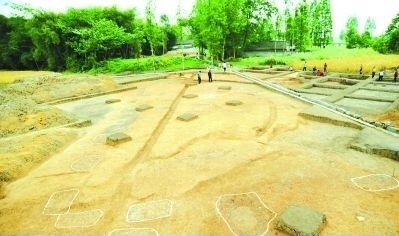An earthquake nearly 3,000 years ago may be the culprit in the mysterious disappearance of one of China's ancient civilizations, new research suggests.
最新研究發現,3000年前的一場地震可能是導致中國一個古文明被毀滅的原因。
The massive temblor may have caused catastrophic landslides, damming up the Sanxingdui culture's main water source and diverting it to a new location.
這次巨大的震動可能引起了災難性的滑坡和山崩,擋住了三星堆文明的主要水源,并將水引到了一個新的地點去。

That, in turn, may have spurred the ancient Chinese culture to move closer to the new river flow, study co-author Niannian Fan, a river sciences researcher at Tsinghua University in Chengdu,China, said Dec. 18 at the 47th annual meeting of the American Geophysical Union in San Francisco.
所以中國的這個古老文明不得不隨著新的水流方向搬遷到新的地方去,成都清華大學的河流科學研究員兼這份研究的合著者范年年在12月18號于舊金山舉行的第47屆美國地球物理學會年會上說。
Ancient civilization
古老文明
In 1929, a peasant in Sichuan province uncovered jade and stone artifacts while repairing a sewage ditch located about 24 miles (40 kilometers) from Chengdu. But their significance wasn't understood until 1986, when archaeologists unearthed two pits of Bronze Age treasures, such as jades, about 100 elephant tusks and stunning8-feet-high (2.4 meters) bronze sculptures that suggest an impressive technicalability that was present nowhere else in the world at the time, said PeterKeller, a geologist and president of the Bowers Museum in Santa Ana,California, which is currently hosting an exhibit of some of these treasures.
1929年,四川一個農民在距離成都40公里處發現了一些玉石工藝品。但是直到1986年人們才發現了這些東西的重要性,當時考古學家們出土了兩處青銅時期的寶藏,比如玉器,大約100個象牙,以及2.4米高的青銅雕塑,這表明中國當時所擁有的高超工藝技術是世界上其他地方所沒有的,加州圣安娜鮑爾斯博物館的地質學家兼主席Peter Keller如是說,該館目前正在展覽這其中的一些寶藏。
The treasures, which had been broken and buried as if they were sacrificed, came from a lost civilization, now known as the Sanxingdui, a walledcity on the banks of the Minjiang River.
這些寶藏——在埋葬之前先被弄破,好像作為一種犧牲品似的——來自一個迷失的文明,即現在所謂的三星堆文明,這是岷江岸邊上的一座城市。
"It's a big mystery," said Keller,who was not involved in the current study.
“這是一個巨大的未解之謎,”PeterKeller說,他并沒有參與目前的這項研究。
Archaeologists now believe that the culture willfully dismantled itself sometime between 3,000 and 2,800 years ago, Fansaid.
考古學家現在認為這個文化在大約3000年到2800年間自行消失,范年年說。
"The current explanations for why it disappeared are war and flood, but both are not very convincing," Fan toldLive Science.
“目前對該文明失落的解釋是戰爭和洪災,但是這兩個理由都不是很讓人信服,”范年年對Live Science說。
But about 14 years ago, archaeologists found the remains of another ancient city called Jinsha near Chengdu. TheJinsha site, though it contained none of the impressive bronzes of Sanxingdui,did have a gold crown with a similar engraved motif of fish, arrows and birdsas a golden staff found at Sanxingdui, Keller said. That has led some scholars to believe that the people from Sanxingdui may have relocated to Jinsha.
但是在14年前,考古學家在成都附近找到了另一座古老城市金沙的遺址。這個金沙遺址雖然不包含有三星堆遺址中出土的青銅器,但是在里面發現了一個金皇冠,上面雕刻有魚,弓箭和鳥,這與三星堆中發現的金物體相似,Keller說。所以有些學者就認為三星堆的人民后來可能遷移到了金沙。
But why has remained a mystery.
但為何依然是個迷。
Geological and historical clues
地質和歷史方面的線索。
Fan and his colleagues wondered whether an earthquake may have caused landslides that dammed the river high up in the mountains and rerouted it to Jinsha. That catastrophe may have reduced Sanxingdui's watersupply, spurring its inhabitants to move.
范和他的同事懷疑是否曾今發生過一次地震,導致滑坡,從而將高山上的河流堵塞,迫使河流改道到金沙。那將導致三星堆的水供給減少,所以促使其居民搬遷。
The valley where Sanxingdui sits has alarge flood plain, with 4.3 miles (7 kilometers) of high terraced walls that were unlikely to have been cut by the small river that now flows through it,Fan said.
三星堆所坐落的山谷上有一個巨型的泛濫平原,其高高的階梯狀墻體長達7公里,不太可能被現在流經這里的小河流所阻斷,范說。
And some historical records support their hypothesis. In 1099 B.C., ancient writers recorded an earthquake in the capitalof the Zhoudynasty, in Shaanxi province, Fan said. Though that spot is roughly 250miles (400 kilometers) from the historic site of Sanxingdui, the latter culture didn't have writing at the time, so it's possible the earthquake epicenter was actually close to Sanxingdui — but it just wasn't recorded there, Fan said.Geological evidence also suggests that an earthquake occurred in the generalregion between 3,330 and 2,200 years ago, he added.
而一些歷史記錄也支持了他們的假設。在公元前1099年,古代作家記錄了在陜西省的周朝首都所發生的一次地震,范說。雖然這個地點距離三星堆遺址有400公里遠,但是由于三星堆當時還沒有書寫文化,所以極有可能這次的地震就發生在三星堆附近,但是沒有書面記錄,范說。地質學上的證據也表明大約在3330年到2200年之間這個大區域發生過一次地震,他說。
Around the same time, geological sediment ssuggest massive flooding occurred, and the later-Han dynasty document "The Chronicles of the Kings of Shu" records ancient floods pouring from amountain in a spot that suggests the flow being rerouted, Fan said. (Around 800 years later, Jinsha residents built a wall to preventflooding.)
大約同時,地質沉積物表明發生了大規模的洪災,在后漢時期的文獻《蜀王編年史》記錄了來自一處山頭的洪水,表明河流被改道了,范說。(大約800年后,金沙居民建了一座墻用來防洪)。
A river rerouted?
一條河流被改道了?
Together, the findings hint that a major earthquake triggered a landslide that dammed the river, rerouting its flow and reducing water flow to Sanxingdui, Fan said.
總之,這些發現向人們暗示了一個大地震引發了滑坡并堵塞了河流,河流從而改道,三星堆所獲得水資源從而減少,范說。
But if so, where did the river getrerouted? The team found clues high up in the mountains in the deep and wideYanmen Ravine, at about 12,460 feet (3,800 meters) above sea level.
如果真是這樣,那河流被改道到哪里去了呢?科研團隊在又深又寬的雁門峽谷的高山上發現了線索,在海平面3800米上。
The modern-day river cuts through theravine, which was carved by glaciers about 12,000 years ago. Yet the telltalesigns of that glacial erosion — bowl-shaped basins known as cirques — are mysteriously absent for a long stretch of the ravine. The team hypothesizes that an earthquake spurred an avalanche that then wiped out some of the cirquesabout 3,000 years ago.
如今的河流穿過了這條峽谷,而這座峽谷是在12000年前由冰川雕琢而成。然而冰川侵蝕的跡象——碗狀的盆地,即盆地谷——在峽谷的很長一段距離里都神秘消失了。該研究團隊推斷3000年前的一次地震引起了大崩塌,所以導致盆地谷的一部分消失。
At this point, the theory is still very speculative, and additional geological data is needed to buttress it, Fan said.
盡管如此,這樣的理論依然是推測性的,需要額外的地質數據來支持這樣的推測,范說。
And while the geological story is possible,Keller said, it doesn't answer the basic question: "What would motivate people to destroy their entire culture and bury it in two pits? And why didn't the culture reemerge at Jinsha?"
雖然從地質學的角度講得通,但是基本的問題依然沒有得到解答:“是什么促使人們摧毀自己的文化并將其埋葬在兩個大坑里?為什么這樣的文化沒有在金沙重新出現?












